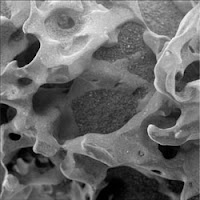From the official Mars Rovers web site:
Hardened Lava Meets Wind on Mars
NASA’s Mars Exploration Rover Spirit used its microscopic imager to capture this spectacular, jagged mini-landscape on a rock called “GongGong.” Measuring only 3 centimeters (1.2 inches) across, this surface records two of the most important and violent forces in the history of Mars — volcanoes and wind.
GongGong formed billions of years ago in a seething, stirring mass of molten rock. It captured bubbles of gases that were trapped at great depth but had separated from the main body of lava as it rose to the surface. Like taffy being stretched and tumbled, the molten rock was deformed as it moved across an ancient Martian landscape. The tiny bubbles of gas were deformed as well, becoming elongated. When the molten lava solidified, the rock looked like a frozen sponge.
Far from finished with its life, the rock then withstood billions of years of pelting by small sand grains carried by Martian dust storms that sometimes blanketed the planet. The sand wore away the surface until, little by little, the delicate strands that enclosed the bubbles of gas were breached and the spiny texture we see today emerged.
Even now, wind continues to deposit sand and dust in the holes and crevices of the rock.
Similar rocks can be found on Earth where the same complex interplay of volcanoes and weathering occur, whether it be the pelting of rocks by sand grains in the Mojave desert or by ice crystals in the frigid Antarctic.
GongGong is one of a group of rocks studied by Spirit and informally named by the Athena Science Team to honor the Chinese New Year (the Year of the Dog). In Chinese mythology, GongGong was the god-king of water in the North Land. When he sacrificed his life to knock down Mount BuZhou, he defeated the bad Emperor in Heaven, freed the sun, moon and stars to go from east to west, and caused all the rivers in China to flow from west to east.
Spirit’s microscopic imager took this image during on the rover’s 736th day, or sol, of exploring Mars (Jan. 28, 2006). The rock lies in the “Inner Basin” between “Husband Hill” and “McCool Hill” in Gusev Crater. Spirit acquired the image while the rock was fully shadowed, with diffuse illumination mostly from the top in this view.
As usual, click on the thumbnail for a larger view of this remarkable micrograph…
